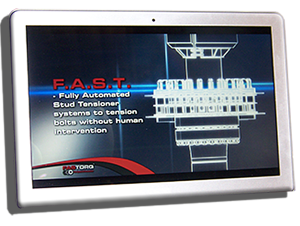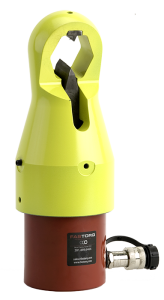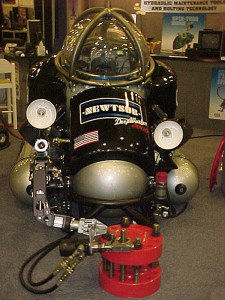How Tool Speed in Subsea Environments Affects Production
It’s not hard to understand that in most cases faster is better. Faster grocery checkout is better. Faster internet service is better. Faster subsea tools are better.
Sadly, when it comes to subsea maintenance, fast is not the term most people would use. When maintenance is slow, subsea production takes a giant hit. If it is not working, it is not producing.
However, many people live with slow because that’s all they believe is out there. By finding innovative tools, like FASTORQ tools, that implement speed and durability into their design, production can get back online faster and with less hassle and breakage.
Torque Wrenches
Take for instance the SpinTORQ. This hydraulic, 360-degree continuously rotating torque wrench has been found to be more than 36 times faster at nut turn than ratcheting wrenches. It even runs off of ROV hydraulics to save time and the difficulty associated with topside pumps and intensifiers used with other torque wrenches.
In tests, SpinTORQ beat the leading competitor’s comparable torque wrench by 80 percent when making up a 12-bolt flange. The Hytorc HY8-XLCT took 45 minutes, 53 seconds to finish. The SpinTORQ IL360-215 completed the make-up in only 9 minutes, 34 seconds. That’s a time savings of 36 minutes and 19 seconds!
In a subsea environment that time savings is even more pronounced, because the SpinTORQ works at the same atmosphere as the ROV and its hydraulic system. It isn’t slowed down by the length of hydraulic hoses and the use of intensifiers.
Dive time and ROVs are expensive. When you use a torque wrench that makes up a flange 80 percent faster, you’ve just got production back online faster.
Stud Tensioners
 Obviously, time spent working subsea is costly, so when it comes to tensioning jobs, it is important to stop playing around with time-consuming stud tensioners. You need to look for tensioners that can save you hundreds of thousands of dollars with just one use and speed up tensioning time significantly.
Obviously, time spent working subsea is costly, so when it comes to tensioning jobs, it is important to stop playing around with time-consuming stud tensioners. You need to look for tensioners that can save you hundreds of thousands of dollars with just one use and speed up tensioning time significantly.
ZipTENSIONERs understand that time is money in subsea tensioning jobs and reduce tensioning time by up to 90 percent. These light and compact tensioners use patented Double ZipNut® Technology to produce the fastest tensioning available. The ZipTENSIONER uses spring-loaded thread segments to allow the tensioner to easily slide on and off protruding stud threads without cross threading and with no worry about rust, corrosion or damaged threads.
These ROV compatible tensioners provide 100-percent same side flange coverage and simultaneously tension on multiple fasteners. By evenly loading on all fasteners in the joint, ZipTENSIONERs eliminate elastic interactions (cross talk) to provide uniform bolt load and achieve leak-free joints.
For even faster tensioning, look to the F.A.S.T. (Fully Automated Stud Tensioner) System. This system takes human interaction out of subsea tensioning through the use of an ROV and ROV hydraulics. Its single unit construction incorporates multiple ZipTENSIONERs into one frame that is guided onto all of the studs on the same side of a flange.
Once in place, all of the tensioners are simultaneously energized and then the reaction nuts are turned down. Once finished, F.A.S.T. removes just as easily as it went on.
Nut Splitters
 When working subsea, there’s no time to mess with difficult tools. Nut splitters are great tools for splitting nuts in a subsea environment. However, the need to make a second cut 180 degrees from the first one to break the nut cleanly away is time consuming and nearly impossible.
When working subsea, there’s no time to mess with difficult tools. Nut splitters are great tools for splitting nuts in a subsea environment. However, the need to make a second cut 180 degrees from the first one to break the nut cleanly away is time consuming and nearly impossible.
Wouldn’t it be great if there was a nut splitter that could cut both sides of the nut cleanly in one action? There is! It is the AutoSPLITTER Double Cut, ® Angle Head nut splitter.
Fast, safe and versatile, the Double-Cut, Angle Head AutoSPLITTER is part of a durable line of nut splitters from FASTORQ. It fits tight spaces and comes with precision, re-sharpenable chisel that cuts only the nut. Available in 5/8-inch to 3-1/2-inch cutting range, AutoSPLITTER cuts through frozen nuts to completely remove them and work in tight spaces and from several angles.
Additional Tools
Bringing flanges together subsea can be an especially difficult task. The ZipPULLER uses ZipNut Technology to pull flanges together in an operation similar to the movement of an inchworm.
By using the ZipPULLER, the need to reset the tool after each stroke is completed, which makes the process considerably faster. In this incredibly challenging subsea application, flange pulling becomes infinitely more productive.
Another tool that uses Double ZipNut Technology, like the ZipTENSIONER mentioned above, is the ZipLIFT. It provides safe and reliable lifting strength in hazardous and difficult subsea areas. The tool utilizes a unique segmented nut that opens while positioned on mating threads and locks onto the threaded rod with the weight of the load when lifted. It will not release the load until is has safely landed because it depends on slack in the line to allow its thread segments to disengage.
The ZipLIFT been used in radioactive areas at Oak Ridge National Laboratory in Tennessee as well as other facilities and in the removal of subsea Christmas trees and BOP’s thanks to its ability to work without direct human intervention.
Finally, when it comes to fast, permanent and irreversible fastening of VIV suppression fairings on subsea risers, ZipNut Technology makes quick work of this job. Vortex Induced Vibration (VIV) is destructive to subsea risers and moorings. By implementing AutoZIP VIV Mechanism Fasteners, such hazards as hurricanes or the long-term effects of regular VIV are no problem.
It is clear, when it comes to subsea work, faster is better. Production takes a hit whenever maintenance is required. If you can use faster subsea tools to speed up maintenance and get back to full production, why don’t you? The time savings of implementing innovative and faster tools will pay you back tenfold.
OCT



About the Author:
Lisa Raynor-Keck is the Marketing Communications Specialist at FASTORQ. She earned her degree in journalism from the University of Central Florida and gained her early writing experience at newspapers in Michigan and Tennessee. In addition to her press positions, Lisa's work portfolio includes experience as a freelance writer, political campaign ad designer and public relations professional. She also has experience working as an editor and writer for the technology division at Middle Tennessee State University and an articles editor for the Navy's former online military lifestyle website Lifelines. Lisa is currently studying to earn her M.A. in corporate communication at Austin Peay State University.